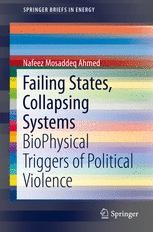In the first of a series, we report on stunning new evidence that the U.S. Department of Defense is waking up to the collapse of American primacy, and the rapid unraveling of the international order created by U.S. power after the Second World War.
But the Pentagon’s emerging vision of what comes next hardly inspires confidence. We breakdown both the insights and cognitive flaws in this vision. In future pieces we will ask the questions: What is really driving the end of the American empire? And based on that more accurate diagnosis of the problem, what is the real solution?
An extraordinary new Pentagon study has concluded that the U.S.-backed international order established after World War 2 is “fraying” and may even be “collapsing”, leading the United States to lose its position of “primacy” in world affairs.
The solution proposed to protect U.S. power in this new “post-primacy” environment is, however, more of the same: more surveillance, more propaganda (“strategic manipulation of perceptions”) and more military expansionism.
The document concludes that the world has entered a fundamentally new phase of transformation in which U.S. power is in decline, international order is unravelling, and the authority of governments everywhere is crumbling.
Having lost its past status of “pre-eminence”, the U.S. now inhabits a dangerous, unpredictable “post-primacy” world, whose defining feature is “resistance to authority”.
Danger comes not just from great power rivals like Russia and China, both portrayed as rapidly growing threats to American interests, but also from the increasing risk of “Arab Spring”-style events. These will erupt not just in the Middle East, but all over the world, potentially undermining trust in incumbent governments for the foreseeable future.
The report, based on a year-long intensive research process involving consultation with key agencies across the Department of Defense and U.S. Army, calls for the U.S. government to invest in more surveillance, better propaganda through “strategic manipulation” of public opinion, and a “wider and more flexible” U.S. military.
The report was published in June by the U.S. Army War College’s Strategic Studies Institute to evaluate the DoD’s approach to risk assessment at all levels of Pentagon policy planning. The study was supported and sponsored by the U.S. Army’s Strategic Plans and Policy Directorate; the Joint Staff, J5 (Strategy and Policy Branch); the Office of the Deputy Secretary of Defense for Strategy and Force Development; and the Army Study Program Management Office.
Collapse
“While the United States remains a global political, economic, and military giant, it no longer enjoys an unassailable position versus state competitors,” the report laments.
“In brief, the status quo that was hatched and nurtured by U.S. strategists after World War II and has for decades been the principal ‘beat’ for DoD is not merely fraying but may, in fact, be collapsing.”
The study describes the essentially imperial nature of this order as being underpinned by American dominance, with the U.S. and its allies literally “dictating” its terms to further their own interests:
“The order and its constituent parts, first emerged from World War II, were transformed to a unipolar system with the collapse of the Soviet Union, and have by-and-large been dominated by the United States and its major Western and Asian allies since. Status quo forces collectively are comfortable with their dominant role in dictating the terms of international security outcomes and resist the emergence of rival centers of power and authority.”
But this era when the U.S. and its allies could simply get their way is over. Observing that U.S. officials “naturally feel an obligation to preserve the U.S. global position within a favorable international order,” the report concludes that this “rules-based global order that the United States built and sustained for 7 decades is under enormous stress.”
The report provides a detailed breakdown of how the DoD perceives this order to be rapidly unravelling, with the Pentagon being increasingly outpaced by world events. Warning that “global events will happen faster than DoD is currently equipped to handle”, the study concludes that the U.S. “can no longer count on the unassailable position of dominance, supremacy, or pre-eminence it enjoyed for the 20-plus years after the fall of the Soviet Union.”
So weakened is U.S. power, that it can no longer even “automatically generate consistent and sustained local military superiority at range.”
It’s not just U.S. power that is in decline. The U.S. Army War College study concludes that:
“[A]ll states and traditional political authority structures are under increasing pressure from endogenous and exogenous forces… The fracturing of the post-Cold War global system is accompanied by the internal fraying in the political, social, and economic fabric of practically all states.”
But, the document says, this should not be seen as defeatism, but rather a “wakeup call”. If nothing is done to adapt to this “post-primacy” environment, the complexity and speed of world events will “increasingly defy [DoD’s] current strategy, planning, and risk assessment conventions and biases.”
Defending the “status quo”
Top on the list of forces that have knocked the U.S. off its position of global “pre-eminence”, says the report, are the role of competing powers — major rivals like Russia and China, as well as smaller players like Iran and North Korea.
The document is particularly candid in setting out why the U.S. sees these countries as threats — not so much because of tangible military or security issues, but mainly because their pursuit of their own legitimate national interests is, in itself, seen as undermining American dominance.
Russia and China are described as “revisionist forces” who benefit from the U.S.-dominated international order, but who dare to “seek a new distribution of power and authority commensurate with their emergence as legitimate rivals to U.S. dominance.” Russia and China, the analysts say, “are engaged in a deliberate program to demonstrate the limits of U.S. authority, will, reach, influence, and impact.”
The premise of this conclusion is that the U.S.-backed “status quo” international order is fundamentally “favorable” for the interests of the U.S. and its allies. Any effort to make global order also work “favorably” for anyone else is automatically seen as a threat to U.S. power and interests.
Thus, Russia and China “seek to reorder their position in the existing status quo in ways that — at a minimum — create more favorable circumstances for pursuit of their core objectives.” At first glance there seems nothing particularly wrong about this. So the analysts emphasize that “a more maximalist perspective sees them pursuing advantage at the direct expense of the United States and its principal Western and Asian allies.”
Most conspicuous of all, there is little substantiation in the document of how Russia and China pose a meaningful threat to American national security.
The chief challenge is that they “are bent on revising the contemporary status quo” through the use of “gray zone” techniques, involving “means and methods falling far short of unambiguous or open provocation and conflict”.
Such “murkier, less obvious forms of state-based aggression”, despite falling short of actual violence, are condemned — but then, losing any sense of moral high-ground, the Pentagon study advocates that the U.S. itself should “go gray or go home” to ensure U.S. influence.
The document also sets out the real reasons that the U.S. is hostile to “revolutionary forces” like Iran and North Korea: they pose fundamental obstacles to U.S. imperial influence in those regions. They are:
“… neither the products of, nor are they satisfied with, the contemporary order… At a minimum, they intend to destroy the reach of the U.S.-led order into what they perceive to be their legitimate sphere of influence. They are also resolved to replace that order locally with a new rule set dictated by them.”
Far from insisting, as the U.S. government does officially, that Iran and North Korea pose as nuclear threats, the document instead insists they are considered problematic for the expansion of the “U.S.-led order.”
Losing the propaganda war
Amidst the challenge posed by these competing powers, the Pentagon study emphasizes the threat from non-state forces undermining the “U.S.-led order” in different ways, primarily through information.
The “hyper-connectivity and weaponization of information, disinformation, and disaffection”, the study team observes, is leading to the uncontrolled spread of information. The upshot is that the Pentagon faces the “inevitable elimination of secrecy and operational security”.
“Wide uncontrolled access to technology that most now take for granted is rapidly undermining prior advantages of discrete, secret, or covert intentions, actions, or operations… In the end, senior defense leaders should assume that all defense-related activity from minor tactical movements to major military operations would occur completely in the open from this point forward.”
This information revolution, in turn, is leading to the “generalized disintegration of traditional authority structures… fueled, and/or accelerated by hyperconnectivity and the obvious decay and potential failure of the post-Cold War status quo.”
Civil unrest
Highlighting the threat posed by groups like ISIS and al-Qaeda, the study also points to “leaderless instability (e.g., Arab Spring)” as a major driver of “a generalized erosion or dissolution of traditional authority structures.”
The document hints that such populist civil unrest is likely to become prominent in Western homelands, including inside the United States.
“To date, U.S. strategists have been fixated on this trend in the greater Middle East. However, the same forces at work there are similarly eroding the reach and authority of governments worldwide… it would be unwise not to recognize that they will mutate, metastasize, and manifest differently over time.”
The U.S. homeland is flagged-up as being especially vulnerable to the breakdown of “traditional authority structures”:
“The United States and its population are increasingly exposed to substantial harm and an erosion of security from individuals and small groups of motivated actors, leveraging the confluence of hyperconnectivity, fear, and increased vulnerability to sow disorder and uncertainty. This intensely disorienting and dislocating form of resistance to authority arrives via physical, virtual, and psychological violence and can create effects that appear substantially out of proportion to the origin and physical size or scale of the proximate hazard or threat.”
There is little reflection, however, on the role of the US government itself in fomenting such endemic distrust, through its own policies.
Bad facts
Among the most dangerous drivers of this risk of civil unrest and mass destabilization, the document asserts, are different categories of fact. Apart from the obvious “fact-free”, defined as information that undermines “objective truth”, the other categories include actual truths that, however, are damaging to America’s global reputation.
“Fact-inconvenient” information consists of the exposure of “details that, by implication, undermine legitimate authority and erode the relationships between governments and the governed” — facts, for instance, that reveal how government policy is corrupt, incompetent or undemocratic.
“Fact-perilous” information refers basically to national security leaks from whistleblowers such as Edward Snowden or Chelsea Manning, “exposing highly classified, sensitive, or proprietary information that can be used to accelerate a real loss of tactical, operational, or strategic advantage.”
“Fact-toxic” information pertains to actual truths which, the document complains, are “exposed in the absence of context”, and therefore poison “important political discourse.” Such information is seen as being most potent in triggering outbreaks of civil unrest, because it:
“… fatally weakens foundational security at an international, regional, national, or personal level. Indeed, fact-toxic exposures are those likeliest to trigger viral or contagious insecurity across or within borders and between or among peoples.”
In short, the U.S. Army War College study team believe that the spread of ‘facts’ challenging the legitimacy of American empire is a major driver of its decline: not the actual behavior of the empire which such facts point to.
Mass surveillance and psychological warfare
The Pentagon study therefore comes up with two solutions to the information threat.
The first is to make better use of U.S. mass surveillance capabilities, which are described as “the largest and most sophisticated and integrated intelligence complex in world.” The U.S. can “generate insight faster and more reliably than its competitors can, if it chooses to do so”. Combined with its “military forward presence and power projection”, the U.S. is in “an enviable position of strength.”
Supposedly, though, the problem is that the U.S. does not make full use of this potential strength:
“That strength, however, is only as durable as the United States’ willingness to see and employ it to its advantage. To the extent that the United States and its defense enterprise are seen to lead, others will follow…”
The document also criticizes U.S. strategies for focusing too much on trying to defend against foreign efforts to penetrate or disrupt U.S. intelligence, at the expense of “the purposeful exploitation of the same architecture for the strategic manipulation of perceptions and its attendant influence on political and security outcomes.”
Pentagon officials need to simply accept, therefore, that:
“… the U.S. homeland, individual American citizens, and U.S. public opinion and perceptions will increasingly become battlefields.”
Military supremacy
Having mourned the loss of U.S. primacy, the Pentagon report sees expanding the U.S. military as the only option.
The bipartisan consensus on military supremacism, however, is not enough. The document demands a military force so powerful it can preserve “maximum freedom of action”, and allow the U.S. to “dictate or hold significant sway over outcomes in international disputes.”
One would be hard-pressed to find a clearer statement of imperial intent in any U.S. Army document:
“While as a rule, U.S. leaders of both political parties have consistently committed to the maintenance of U.S. military superiority over all potential state rivals, the post-primacy reality demands a wider and more flexible military force that can generate advantage and options across the broadest possible range of military demands. To U.S. political leadership, maintenance of military advantage preserves maximum freedom of action… Finally, it allows U.S. decision-makers the opportunity to dictate or hold significant sway over outcomes in international disputes in the shadow of significant U.S. military capability and the implied promise of unacceptable consequences in the event that capability is unleashed.”
Once again, military power is essentially depicted as a tool for the U.S. to force, threaten and cajole other countries into submission to U.S. demands.
The very concept of ‘defence’ is thus re-framed as the capacity to use overwhelming military might to get one’s way — anything which undermines this capacity ends up automatically appearing as a threat that deserves to be attacked.
Empire of capital
Accordingly, a core goal of this military expansionism is ensuring that the United States and its international partners have “unimpeded access to air, sea, space, cyberspace, and the electromagnetic spectrum in order to underwrite their security and prosperity”.
This also means that the U.S. must retain the ability to physically access any region it wants, whenever it wants:
“Failure of or limitations on the ability of the United States to enter and operate within key regions of the world, for example, undermine both U.S. and partner security.”
The U.S. thus must try to minimize any “purposeful, malevolent, or incidental interruption of access to the commons, as well as critical regions, resources, and markets.”
Without ever referring directly to ‘capitalism’, the document eliminates any ambiguity about how the Pentagon sees this new era of “Persistent Conflict 2.0”:
“… some are fighting globalization and globalization is also actively fighting back. Combined, all of these forces are rending at the fabric of security and stable governance that all states aspire to and rely on for survival.”
This is a war, then, between US-led capitalist globalization, and anyone who resists it.
And to win it, the document puts forward a combination of strategies: consolidating the U.S. intelligence complex and using it more ruthlessly; intensifying mass surveillance and propaganda to manipulate popular opinion; expanding U.S. military clout to ensure access to “strategic regions, markets, and resources”.
Even so, the overarching goal is somewhat more modest — to prevent the U.S.-led order from collapsing further:
“…. while the favorable U.S.-dominated status quo is under significant internal and external pressure, adapted American power can help to forestall or even reverse outright failure in the most critical regions”.
The hope is that the U.S. will be able to fashion “a remodeled but nonetheless still favorable post-primacy international order.”
Narcissism
Like all U.S. Army War College publications, the document states that it does not necessarily represent the official position of the U.S. Army or DoD. While this caveat means that its findings cannot be taken to formally represent the U.S. government, the document does also admit that it represents “the collective wisdom” of the numerous officials consulted.
In that sense, the document is a uniquely insightful window into the mind of the Pentagon, and how embarrassingly limited its cognitive scope really is.
And this in turn reveals not only why the Pentagon’s approach is bound to make things worse, but also what an alternative more productive approach might look like.
Launched in June 2016 and completed in April 2017, the U.S. Army War College research project involved extensive consultation with officials across the Pentagon, including representatives of the joint and service staffs, the Office of the Secretary of Defense (OSD), U.S. Central Command (USCENTCOM), U.S. Pacific Command (USPACOM), U.S. Northern Command (USNORTHCOM), U.S. Special Operations Command (USSOCOM); U.S. Forces, Japan (USFJ), the Defense Intelligence Agency (DIA), the National Intelligence Council, U.S. Strategic Command (USSTRATCOM), and U.S. Army Pacific [USARPAC] and Pacific Fleet [PACFLT]).
The study team also consulted with a handful of American think-tanks of a somewhat neoconservative persuasion: the American Enterprise Institute, the Center for Strategic and International Studies (CSIS), the RAND Corporation, and the Institute for the Study of War.
No wonder, then, that its findings are so myopic.
But what else would you expect from a research process so deeply narcissistic, that it involves little more than talking to yourself? Is it any wonder that the solutions offered represent an echo chamber calling to amplify precisely the same policies that have contributed to the destabilization of U.S. power?
The research methodology manages to systematically ignore the most critical evidence surrounding the drivers undermining U.S. primacy: such as, the biophysical processes of climate, energy and food disruption behind the Arab Spring; the confluence of military violence, fossil fuel interests and geopolitical alliances behind the rise of ISIS; or the fundamental grievances that have driven a breakdown in trust with governments since the 2008 financial collapse and the ensuing ongoing period of neoliberal economic failure.

A large body of data demonstrates that the escalating risks to U.S. power have come not from outside U.S. power, but from the very manner in which U.S. power has operated. The breakdown of the U.S.-led international order, from this perspective, is happening as a direct consequence of deep-seated flaws in the structure, values and vision of that order.
In this context, the study’s conclusions are less a reflection of the actual state of the world, than of the way the Pentagon sees itself and the world.
Indeed, most telling of all is the document’s utter inability to recognize the role of the Pentagon itself in systematically pursuing a wide range of policies over the last several decades which have contributed directly to the very instability it now wants to defend against.
The Pentagon frames itself as existing outside the Hobbesian turmoil that it conveniently projects onto the world — the result is a monumental and convenient rejection of any sense of responsibility for what happens in the world.
In this sense, the document is a powerful illustration of the self-limiting failure of conventional risk-assessment approaches. What is needed instead is a systems-oriented approach based on evaluating not just the Pentagon’s internal beliefs about the drivers of risk — but engaging with independent scientific evidence about those drivers to test the extent to which those beliefs withstand rigorous scrutiny.
Such an approach could open the door to a very different scenario to the one recommended by this document — one based on a willingness to actually look in the mirror. And that in turn might open up the opportunity for Pentagon officials to imagine alternative policies with a real chance of actually working, rather than reinforcing the same stale failed strategies of the past.
It is no surprise then that even the Pentagon’s apparent conviction in the inexorable decline of U.S. power could well be overblown.
According to Dr Sean Starrs of MIT’s Center for International Studies, a true picture of U.S. power cannot be determined solely from national accounts. We have to look at the accounts of transnational corporations.
Starrs shows that American transnational corporations are vastly more powerful than their competitors. His data suggests that American economic supremacism remains at an all-time high, and still unchallenged even by an economic powerhouse like China.
This does not necessarily discredit the Pentagon’s emerging recognition that U.S. imperial power faces a new era of decline and unprecedented volatility.
But it does suggest that the Pentagon’s sense of U.S. global pre-eminence is very much bound up with its capacity to project American capitalism globally.
As geopolitical rivals agitate against U.S. economic reach, and as new movements emerge hoping to undermine American “unimpeded access” to global resources and markets, what’s clear is that DoD officials see anything which competes with or undermines American capitalism as a clear and present danger.
But nothing put forward in this document will actually contribute to slowing the decline of U.S. power.
On the contrary, the Pentagon study’s recommendations call for an intensification of the very imperial policies that futurist Professor Johan Galtung, who accurately forecasted the demise of the USSR, predicts will accelerate the “collapse of the U.S. empire” by around 2020.
As we move deeper into the “post-primacy” era, the more meaningful question for people, governments, civil society and industry is this: as the empire falls, lashing out in its death throes, what comes after?
This article was amended on July 19th, 2017 to change the reference to whistleblower “Bradley Manning” to “Chelsea Manning”









